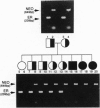Abstract
Estrogen receptor and its ligand, estradiol, have long been thought to be essential for survival, fertility, and female sexual differentiation and development. Consistent with this proposed crucial role, no human estrogen receptor gene mutations are known, unlike the androgen receptor, where many loss of function mutations have been found. We have generated mutant mice lacking responsiveness to estradiol by disrupting the estrogen receptor gene by gene targeting. Both male and female animals survive to adulthood with normal gross external phenotypes. Females are infertile; males have a decreased fertility. Females have hypoplastic uteri and hyperemic ovaries with no detectable corpora lutea. In adult wild-type and heterozygous females, 3-day estradiol treatment at 40 micrograms/kg stimulates a 3- to 4-fold increase in uterine wet weight and alters vaginal cornification, but the uteri and vagina do not respond in the animals with the estrogen receptor gene disruption. Prenatal male and female reproductive tract development can therefore occur in the absence of estradiol receptor-mediated responsiveness.
Full text
PDF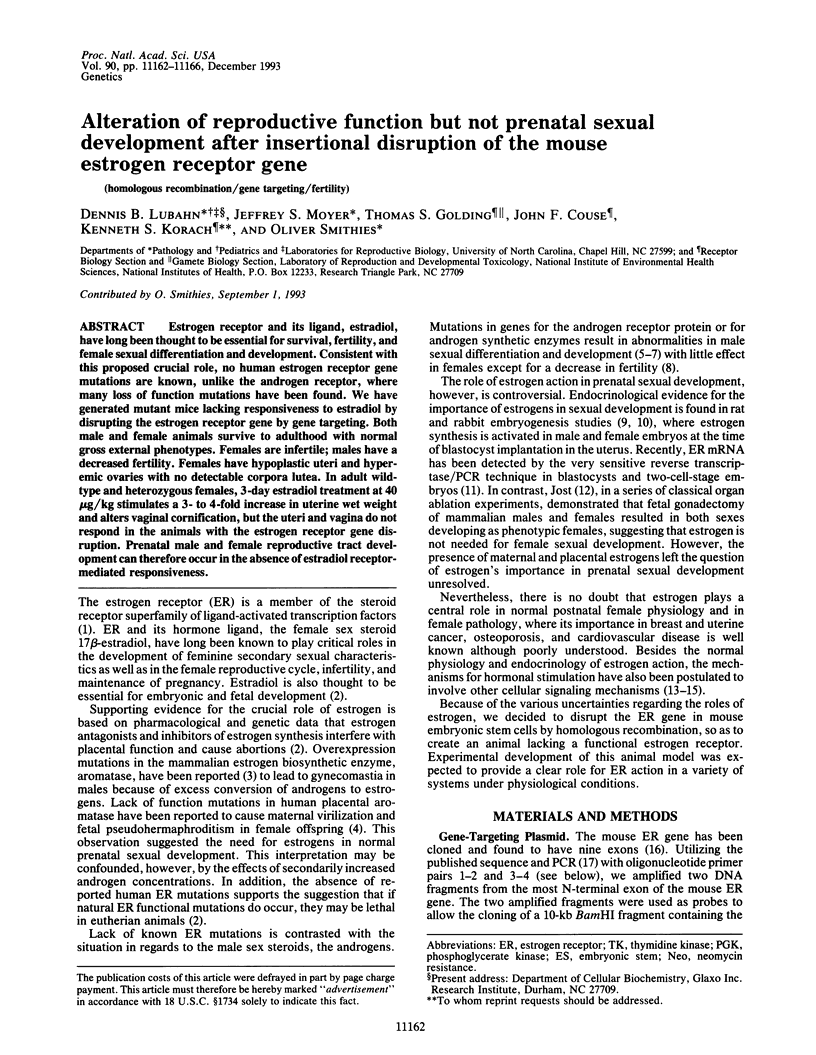
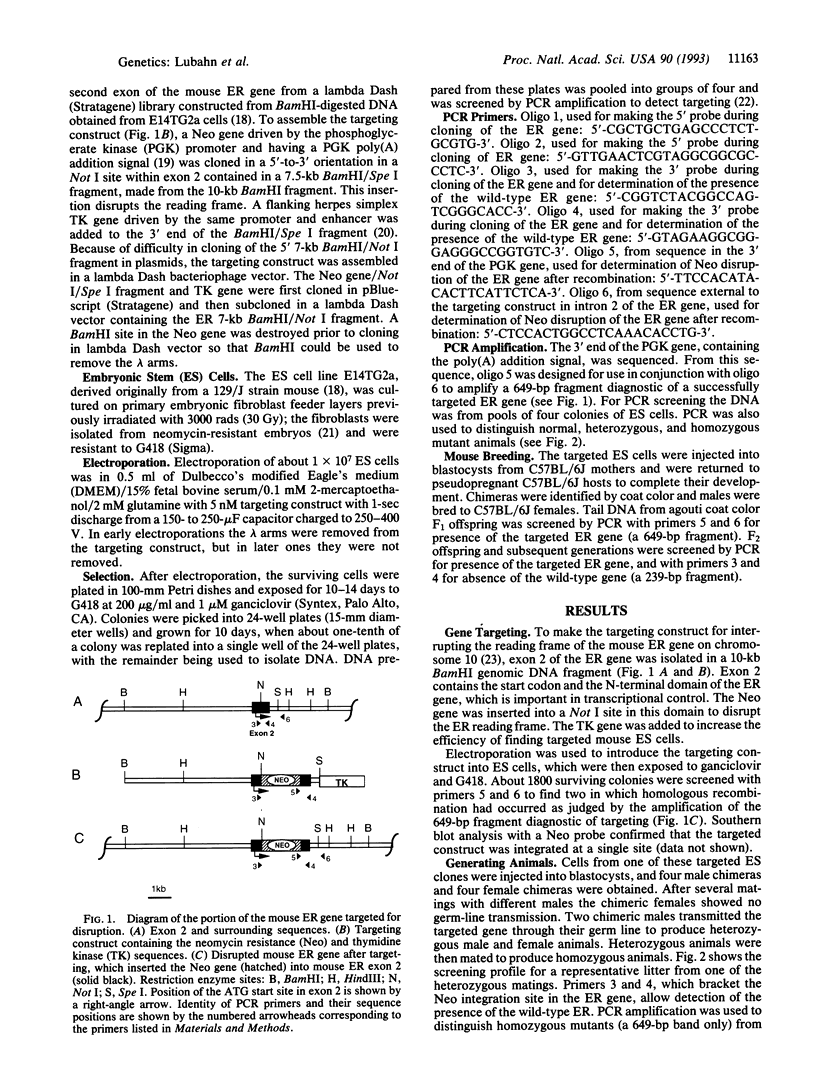
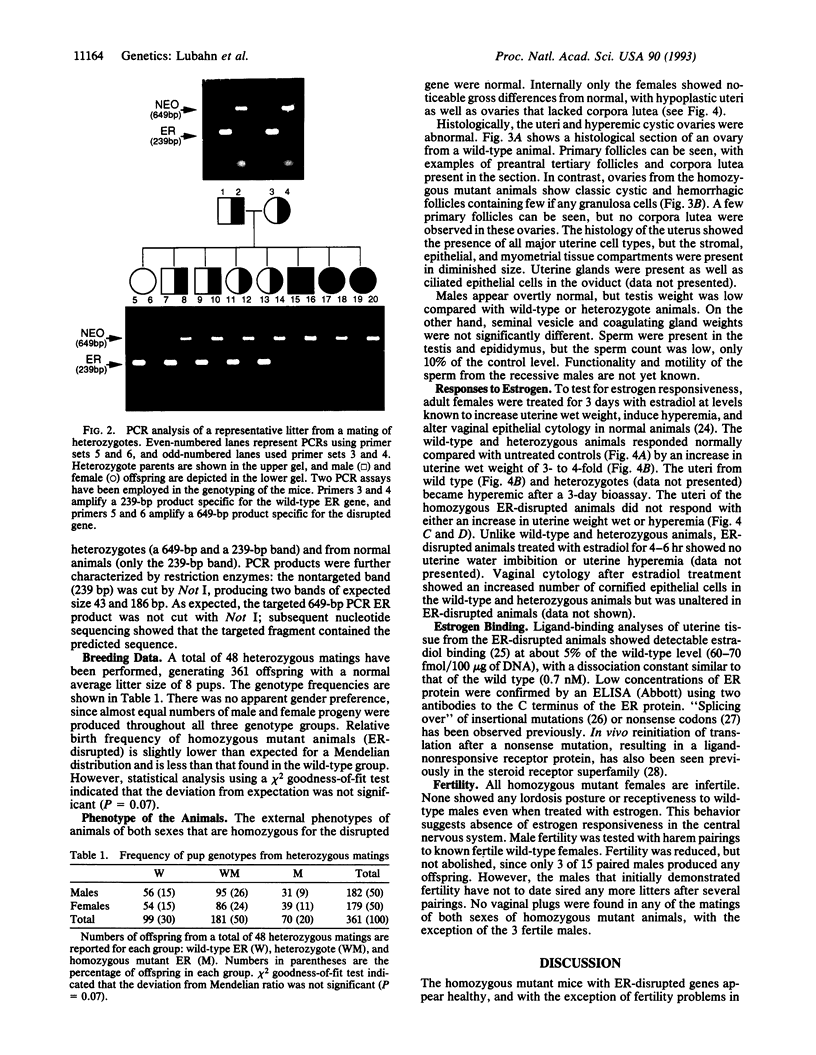
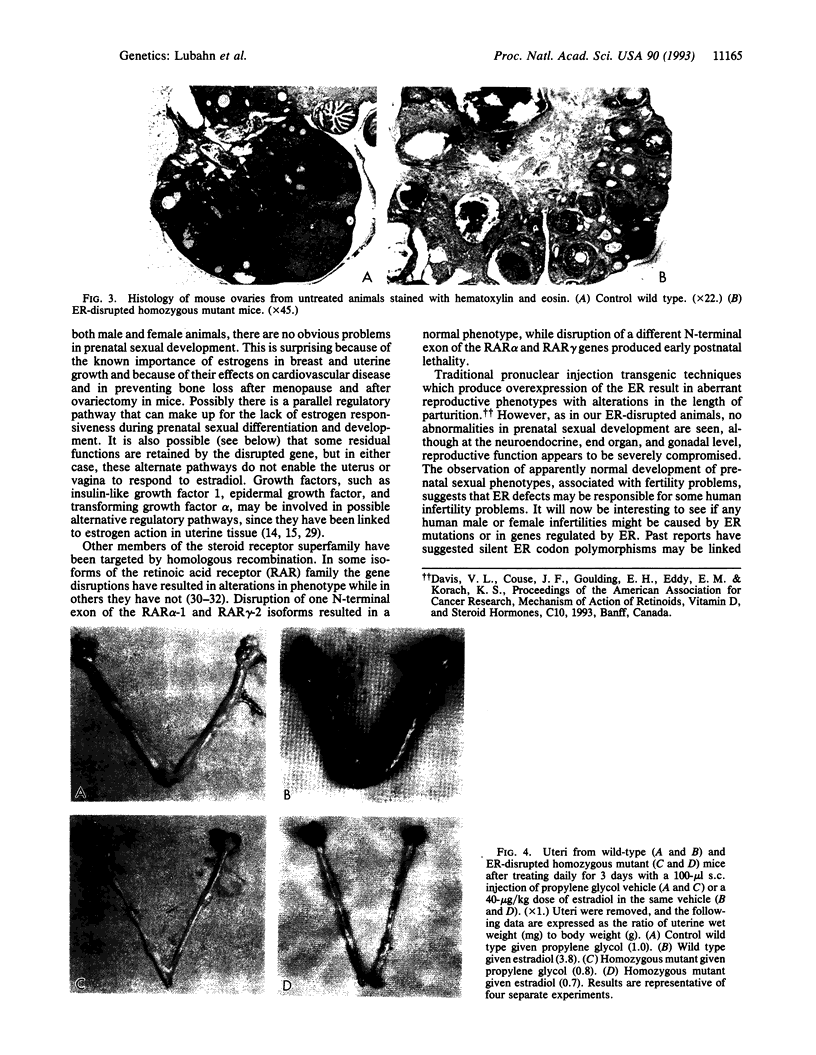
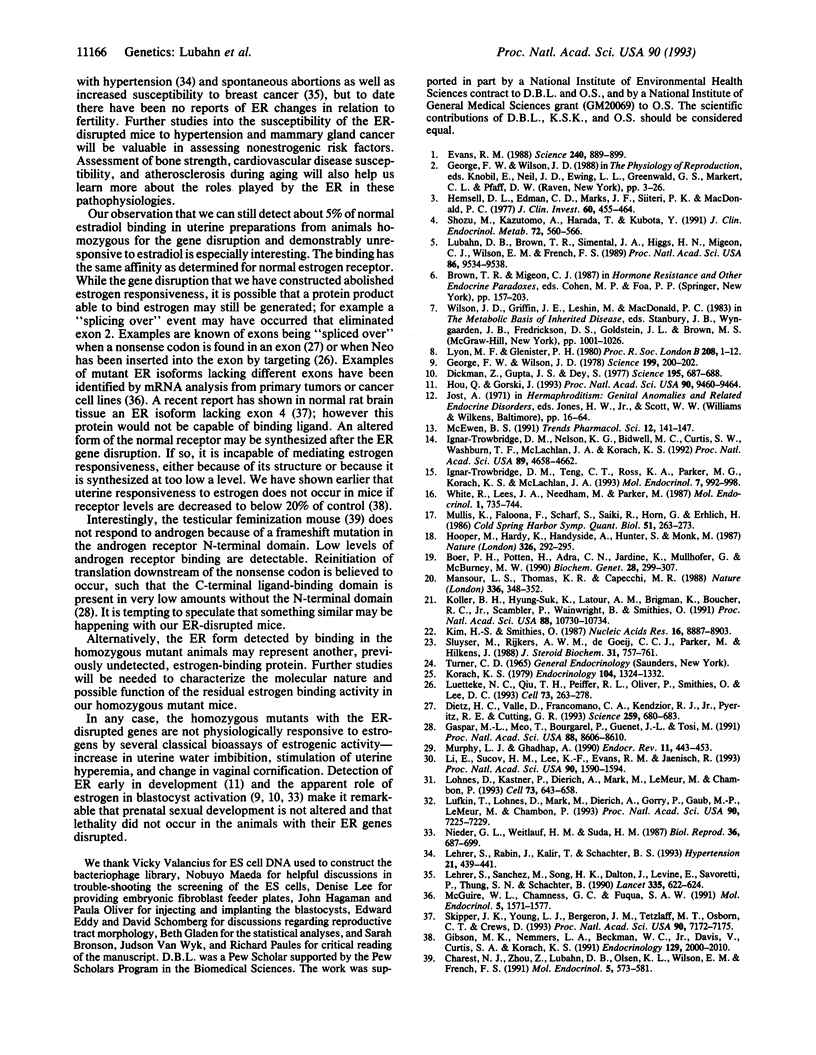
Images in this article
Selected References
These references are in PubMed. This may not be the complete list of references from this article.
- Boer P. H., Potten H., Adra C. N., Jardine K., Mullhofer G., McBurney M. W. Polymorphisms in the coding and noncoding regions of murine Pgk-1 alleles. Biochem Genet. 1990 Jun;28(5-6):299–308. doi: 10.1007/BF02401419. [DOI] [PubMed] [Google Scholar]
- Charest N. J., Zhou Z. X., Lubahn D. B., Olsen K. L., Wilson E. M., French F. S. A frameshift mutation destabilizes androgen receptor messenger RNA in the Tfm mouse. Mol Endocrinol. 1991 Apr;5(4):573–581. doi: 10.1210/mend-5-4-573. [DOI] [PubMed] [Google Scholar]
- Dickmann Z., Gupta J. S., Dey S. K. Does "blastocyst estrogen" initiate implantation? Science. 1977 Feb 18;195(4279):687–688. doi: 10.1126/science.841306. [DOI] [PubMed] [Google Scholar]
- Dietz H. C., Valle D., Francomano C. A., Kendzior R. J., Jr, Pyeritz R. E., Cutting G. R. The skipping of constitutive exons in vivo induced by nonsense mutations. Science. 1993 Jan 29;259(5095):680–683. doi: 10.1126/science.8430317. [DOI] [PubMed] [Google Scholar]
- Evans R. M. The steroid and thyroid hormone receptor superfamily. Science. 1988 May 13;240(4854):889–895. doi: 10.1126/science.3283939. [DOI] [PMC free article] [PubMed] [Google Scholar]
- Gaspar M. L., Meo T., Bourgarel P., Guenet J. L., Tosi M. A single base deletion in the Tfm androgen receptor gene creates a short-lived messenger RNA that directs internal translation initiation. Proc Natl Acad Sci U S A. 1991 Oct 1;88(19):8606–8610. doi: 10.1073/pnas.88.19.8606. [DOI] [PMC free article] [PubMed] [Google Scholar]
- George F. W., Wilson J. D. Estrogen formation in the early rabbit embryo. Science. 1978 Jan 13;199(4325):200–201. doi: 10.1126/science.579477. [DOI] [PubMed] [Google Scholar]
- Gibson M. K., Nemmers L. A., Beckman W. C., Jr, Davis V. L., Curtis S. W., Korach K. S. The mechanism of ICI 164,384 antiestrogenicity involves rapid loss of estrogen receptor in uterine tissue. Endocrinology. 1991 Oct;129(4):2000–2010. doi: 10.1210/endo-129-4-2000. [DOI] [PubMed] [Google Scholar]
- Hemsell D. L., Edman C. D., Marks J. F., Siiteri P. K., MacDonald P. C. Massive extranglandular aromatization of plasma androstenedione resulting in feminization of a prepubertal boy. J Clin Invest. 1977 Aug;60(2):455–464. doi: 10.1172/JCI108796. [DOI] [PMC free article] [PubMed] [Google Scholar]
- Hooper M., Hardy K., Handyside A., Hunter S., Monk M. HPRT-deficient (Lesch-Nyhan) mouse embryos derived from germline colonization by cultured cells. Nature. 1987 Mar 19;326(6110):292–295. doi: 10.1038/326292a0. [DOI] [PubMed] [Google Scholar]
- Hou Q., Gorski J. Estrogen receptor and progesterone receptor genes are expressed differentially in mouse embryos during preimplantation development. Proc Natl Acad Sci U S A. 1993 Oct 15;90(20):9460–9464. doi: 10.1073/pnas.90.20.9460. [DOI] [PMC free article] [PubMed] [Google Scholar]
- Ignar-Trowbridge D. M., Nelson K. G., Bidwell M. C., Curtis S. W., Washburn T. F., McLachlan J. A., Korach K. S. Coupling of dual signaling pathways: epidermal growth factor action involves the estrogen receptor. Proc Natl Acad Sci U S A. 1992 May 15;89(10):4658–4662. doi: 10.1073/pnas.89.10.4658. [DOI] [PMC free article] [PubMed] [Google Scholar]
- Ignar-Trowbridge D. M., Teng C. T., Ross K. A., Parker M. G., Korach K. S., McLachlan J. A. Peptide growth factors elicit estrogen receptor-dependent transcriptional activation of an estrogen-responsive element. Mol Endocrinol. 1993 Aug;7(8):992–998. doi: 10.1210/mend.7.8.8232319. [DOI] [PubMed] [Google Scholar]
- Kim H. S., Smithies O. Recombinant fragment assay for gene targetting based on the polymerase chain reaction. Nucleic Acids Res. 1988 Sep 26;16(18):8887–8903. doi: 10.1093/nar/16.18.8887. [DOI] [PMC free article] [PubMed] [Google Scholar]
- Koller B. H., Kim H. S., Latour A. M., Brigman K., Boucher R. C., Jr, Scambler P., Wainwright B., Smithies O. Toward an animal model of cystic fibrosis: targeted interruption of exon 10 of the cystic fibrosis transmembrane regulator gene in embryonic stem cells. Proc Natl Acad Sci U S A. 1991 Dec 1;88(23):10730–10734. doi: 10.1073/pnas.88.23.10730. [DOI] [PMC free article] [PubMed] [Google Scholar]
- Korach K. S. Estrogen action in the mouse uterus: characterization of the cytosol and nuclear receptor systems. Endocrinology. 1979 May;104(5):1324–1332. doi: 10.1210/endo-104-5-1324. [DOI] [PubMed] [Google Scholar]
- Lehrer S., Rabin J., Kalir T., Schachter B. S. Estrogen receptor variant and hypertension in women. Hypertension. 1993 Apr;21(4):439–441. doi: 10.1161/01.hyp.21.4.439. [DOI] [PubMed] [Google Scholar]
- Lehrer S., Sanchez M., Song H. K., Dalton J., Levine E., Savoretti P., Thung S. N., Schachter B. Oestrogen receptor B-region polymorphism and spontaneous abortion in women with breast cancer. Lancet. 1990 Mar 17;335(8690):622–624. doi: 10.1016/0140-6736(90)90410-7. [DOI] [PubMed] [Google Scholar]
- Li E., Sucov H. M., Lee K. F., Evans R. M., Jaenisch R. Normal development and growth of mice carrying a targeted disruption of the alpha 1 retinoic acid receptor gene. Proc Natl Acad Sci U S A. 1993 Feb 15;90(4):1590–1594. doi: 10.1073/pnas.90.4.1590. [DOI] [PMC free article] [PubMed] [Google Scholar]
- Lohnes D., Kastner P., Dierich A., Mark M., LeMeur M., Chambon P. Function of retinoic acid receptor gamma in the mouse. Cell. 1993 May 21;73(4):643–658. doi: 10.1016/0092-8674(93)90246-m. [DOI] [PubMed] [Google Scholar]
- Lubahn D. B., Brown T. R., Simental J. A., Higgs H. N., Migeon C. J., Wilson E. M., French F. S. Sequence of the intron/exon junctions of the coding region of the human androgen receptor gene and identification of a point mutation in a family with complete androgen insensitivity. Proc Natl Acad Sci U S A. 1989 Dec;86(23):9534–9538. doi: 10.1073/pnas.86.23.9534. [DOI] [PMC free article] [PubMed] [Google Scholar]
- Luetteke N. C., Qiu T. H., Peiffer R. L., Oliver P., Smithies O., Lee D. C. TGF alpha deficiency results in hair follicle and eye abnormalities in targeted and waved-1 mice. Cell. 1993 Apr 23;73(2):263–278. doi: 10.1016/0092-8674(93)90228-i. [DOI] [PubMed] [Google Scholar]
- Lufkin T., Lohnes D., Mark M., Dierich A., Gorry P., Gaub M. P., LeMeur M., Chambon P. High postnatal lethality and testis degeneration in retinoic acid receptor alpha mutant mice. Proc Natl Acad Sci U S A. 1993 Aug 1;90(15):7225–7229. doi: 10.1073/pnas.90.15.7225. [DOI] [PMC free article] [PubMed] [Google Scholar]
- Lyon M. F., Glenister P. H. Reduced reproductive performance in androgen-resistant Tfm/Tfm female mice. Proc R Soc Lond B Biol Sci. 1980 Jun 23;208(1170):1–12. doi: 10.1098/rspb.1980.0040. [DOI] [PubMed] [Google Scholar]
- Mansour S. L., Thomas K. R., Capecchi M. R. Disruption of the proto-oncogene int-2 in mouse embryo-derived stem cells: a general strategy for targeting mutations to non-selectable genes. Nature. 1988 Nov 24;336(6197):348–352. doi: 10.1038/336348a0. [DOI] [PubMed] [Google Scholar]
- McEwen B. S. Non-genomic and genomic effects of steroids on neural activity. Trends Pharmacol Sci. 1991 Apr;12(4):141–147. doi: 10.1016/0165-6147(91)90531-v. [DOI] [PubMed] [Google Scholar]
- McGuire W. L., Chamness G. C., Fuqua S. A. Estrogen receptor variants in clinical breast cancer. Mol Endocrinol. 1991 Nov;5(11):1571–1577. doi: 10.1210/mend-5-11-1571. [DOI] [PubMed] [Google Scholar]
- Mullis K., Faloona F., Scharf S., Saiki R., Horn G., Erlich H. Specific enzymatic amplification of DNA in vitro: the polymerase chain reaction. Cold Spring Harb Symp Quant Biol. 1986;51(Pt 1):263–273. doi: 10.1101/sqb.1986.051.01.032. [DOI] [PubMed] [Google Scholar]
- Murphy L. J., Ghahary A. Uterine insulin-like growth factor-1: regulation of expression and its role in estrogen-induced uterine proliferation. Endocr Rev. 1990 Aug;11(3):443–453. doi: 10.1210/edrv-11-3-443. [DOI] [PubMed] [Google Scholar]
- Nieder G. L., Weitlauf H. M., Suda-Hartman M. Synthesis and secretion of stage-specific proteins by peri-implantation mouse embryos. Biol Reprod. 1987 Apr;36(3):687–699. doi: 10.1095/biolreprod36.3.687. [DOI] [PubMed] [Google Scholar]
- Shozu M., Akasofu K., Harada T., Kubota Y. A new cause of female pseudohermaphroditism: placental aromatase deficiency. J Clin Endocrinol Metab. 1991 Mar;72(3):560–566. doi: 10.1210/jcem-72-3-560. [DOI] [PubMed] [Google Scholar]
- Skipper J. K., Young L. J., Bergeron J. M., Tetzlaff M. T., Osborn C. T., Crews D. Identification of an isoform of the estrogen receptor messenger RNA lacking exon four and present in the brain. Proc Natl Acad Sci U S A. 1993 Aug 1;90(15):7172–7175. doi: 10.1073/pnas.90.15.7172. [DOI] [PMC free article] [PubMed] [Google Scholar]
- Sluyser M., Rijkers A. W., de Goeij C. C., Parker M., Hilkens J. Assignment of estradiol receptor gene to mouse chromosome 10. J Steroid Biochem. 1988 Nov;31(5):757–761. doi: 10.1016/0022-4731(88)90283-x. [DOI] [PubMed] [Google Scholar]
- White R., Lees J. A., Needham M., Ham J., Parker M. Structural organization and expression of the mouse estrogen receptor. Mol Endocrinol. 1987 Oct;1(10):735–744. doi: 10.1210/mend-1-10-735. [DOI] [PubMed] [Google Scholar]



